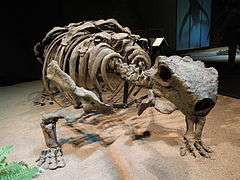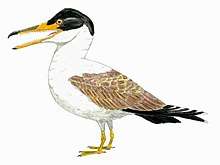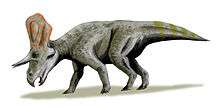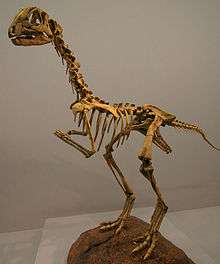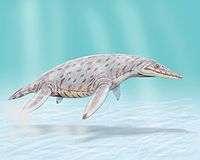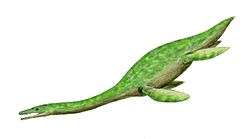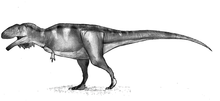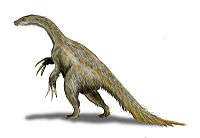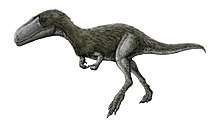Turonian
The Turonian is, in the ICS' geologic timescale, the second age in the Late Cretaceous epoch, or a stage in the Upper Cretaceous series. It spans the time between 93.9 ± 0.8 Ma and 89.8 ± 1 Ma (million years ago). The Turonian is preceded by the Cenomanian stage and underlies the Coniacian stage.[2]
| System/ Period |
Series/ Epoch |
Stage/ Age |
Age (Ma) | |
|---|---|---|---|---|
| Paleogene | Paleocene | Danian | younger | |
| Cretaceous | Upper/ Late |
Maastrichtian | 66.0 | 72.1 |
| Campanian | 72.1 | 83.6 | ||
| Santonian | 83.6 | 86.3 | ||
| Coniacian | 86.3 | 89.8 | ||
| Turonian | 89.8 | 93.9 | ||
| Cenomanian | 93.9 | 100.5 | ||
| Lower/ Early |
Albian | 100.5 | ~113.0 | |
| Aptian | ~113.0 | ~125.0 | ||
| Barremian | ~125.0 | ~129.4 | ||
| Hauterivian | ~129.4 | ~132.9 | ||
| Valanginian | ~132.9 | ~139.8 | ||
| Berriasian | ~139.8 | ~145.0 | ||
| Jurassic | Upper/ Late |
Tithonian | older | |
| Subdivision of the Cretaceous system according to the ICS, as of 2017.[1] | ||||
At the beginning of the Turonian an anoxic event took place which is called the Cenomanian-Turonian boundary event or the "Bonarelli Event".
Stratigraphic definition
The Turonian (French: Turonien) was defined by the French paleontologist Alcide d'Orbigny (1802–1857) in 1842. Orbigny named it after the French city of Tours in the region of Touraine (department Indre-et-Loire), which is the original type locality.
The base of the Turonian stage is defined as the place where the ammonite species Wutinoceras devonense first appears in the stratigraphic column. The official reference profile (the GSSP) for the base of the Turonian is located in the Rock Canyon anticline near Pueblo, Colorado (United States, coordinates: 38° 16' 56" N, 104° 43' 39" W).[3]
The top of the Turonian stage (the base of the Coniacian) is defined as the place in the stratigraphic column where the inoceramid bivalve species Cremnoceramus rotundatus first appears.
Subdivision
The Turonian is sometimes subdivided in Lower/Early, Middle and Upper/Late substages or subages. In the Tethys domain, it contains the following ammonite biozones:
- zone of Subprionocyclus neptuni (in the Upper Turonian)
- zone of Collignoniceras woollgari (in the Middle Turonian)
- zone of Mammites nodosoides
- zone of Watinoceras coloradoense or Watinoceras devonense (last two both in the Lower Turonian)
Other important index fossils are species of the inoceramid genus Inoceramus (I. schloenbachi, I. lamarcki and I. labiatus). Inoceramids are bivalve Mollusca related to today's mussels.
Palaeontology
Ankylosaurs
| Ankylosaurs of the Turonian | ||||
|---|---|---|---|---|
| Taxa | Presence | Location | Description | Images |
| Mongolia | ||||
| Bayan Shireh Formation, Mongolia | ||||
Avialans
| Avialans of the Turonian | ||||
|---|---|---|---|---|
| Taxa | Presence | Location | Description | Images |
| Bissekty Formation, Uzbekistan | A mid-sized enantiornithine, perhaps 20–25 cm long in life | |||
| Bissekty Formation, Uzbekistan | ||||
| Turonian - Campanian | Alberta and Saskatchewan, Canada; Alabama, Kansas, New Mexico and Texas, USA; Argentina; Central Asia | The Cretaceous ecological equivalent of modern seabirds such as gulls, petrels, and skimmers. At 60 cm (2.0 ft), it was the size of a gull. Although the wings and breastbone are very modern in appearance (suggesting strong flight ability), the jaws retained numerous small, sharp teeth | ||
Ceratopsians
| Ceratopsia of the Turonian | ||||
|---|---|---|---|---|
| Taxa | Presence | Location | Description | Images |
| Moreno Hill Formation, New Mexico, USA | The earliest-known ceratopsian to have eyebrow horns and the oldest-known ceratopsian from North America, appears to have been roughly 3 to 3.5 meters (9.8 to 11.5 ft) long and 1 meter (3.3 feet) tall at the hips. | |||
Crocodylomorphs
| Crocodylomorpha of the Turonian | ||||
|---|---|---|---|---|
| Taxa | Presence | Location | Description | Images |
| Brazil | ||||
| Turonian to Santonian | Adamantina Formation, São Paulo, Brazil | A terrestrial peirosaurid | ||
| Brazil | ||||
| Fergana Basin, Tajikistan; Bissekty Formation, Dzharakhuduk, Uzbekistan | An early alligatoroid very similar to Diplocynodon from the Cenozoic. | |||
Mammals
| Mammalia of the Turonian | ||||
|---|---|---|---|---|
| Taxa | Presence | Location | Description | Images |
| Straight Cliffs Formation of Utah, US. | Smaller than a mouse, thought to behave somewhat similar. | |||
Ornithopods
| Ornithopoda of the Turonian | ||||
|---|---|---|---|---|
| Taxa | Presence | Location | Description | Images |
| Cerro Lisandro Formation, Neuquén Province, Patagonia, Argentina | A 2 metres (6.6 ft) long elasmarian | |||
| Turonian to Coniacian | Gobi Desert, Mongolia and China | Would have been 6 m (20 ft) long[1] and 2 m (6.6 ft) high when in the quadrupedal stance, and weighed 1,100–1,500 kg (2,400–3,300 lb). Like many hadrosaurs, it could switch between bipedal and quadrupedal stances, but unusually it had large spines protruding from the vertebrae. | ||
| Jeyawati | Turonian | Moreno Hill Formation, New Mexico | A basal hadrosauroid | |
| Turonian to early Coniacian | Portezuelo Formation, Argentina | A genus of basal iguanodont, a large bipedal herbivore | ||
| Cenomanian-Turonian | Bajo Barreal Formation, Chubut, Argentina | A hypsilophodontid or other basal ornithopod, Notohypsilophodon would have been a bipedal herbivore. Its size has not been estimated | ||
| Cenomanian-Turonian | China | A poorly known iguanodont | ||
Plesiosaurs
| Plesiosauria of the Turonian | ||||
|---|---|---|---|---|
| Taxa | Presence | Location | Description | Images |
| Ottawa County, Kansas | Brachauchenius represents the last known occurrence of a pliosaur in North America. | |||
| Britton Formation (Cedar Hill), Texas, USA | A 7–14 m (23–46 ft) long creature, was very similar to the related Elasmosaurus. It had a compact body with a short tail and large flippers. Its small skull had long, forward-facing teeth ideal for catching slippery fish and squid that came together outside of its mouth when the mouth was closed, and was placed atop a very long neck. | |||
| Morocco | A genus of polycotylid plesiosaur | |||
| Carlile Shale, Russell County, Kansas | ||||
|
Polyptychodon hudsoni |
Texas, USA | A 10 metres (33 ft) long Brachaucheniin pliosaurid | ||
| High Atlas, Morocco | A genus of polycotylid plesiosaur, the estimated total length of Thililua is 5.5 to 6 metres. | |||
Pterosaurs
| Pterosaurs of the Turonian | ||||
|---|---|---|---|---|
| Taxa | Presence | Location | Description | Images |
| Upper Chalk, Kent, England | ||||
| Albian-Turonian | Chalk Formation, Kent and Cambridge Greensand, England | |||
Squamatans
| Squamata of the Turonian | ||||
|---|---|---|---|---|
| Taxa | Presence | Location | Description | Images |
| Arcadia Park Shale, Texas, USA | A basal, small, plesiopedal mososauroid | |||
| Arcadia Park Shale, Texas, USA | A basal, small, lightly built mosasaur | |||
Theropods (non-avialan)
| Theropods of the Turonian | ||||
|---|---|---|---|---|
| Taxa | Presence | Location | Description | Images |
|
Neuquén, Argentina | |||
| Khara Khutul, Mongolia | ||||
| Bayan Shireh Formation of Mongolia | ||||
| Huincul Formation, Argentina | ||||
| New Mexico, USA | ||||
| Khan-Bogdsomona, Mongolia | ||||
| Kyzylkum Desert, Uzbekistan | A small (250 kg) tyrannosauroid. | |||
| Uzbekistan | ||||
| Bajo Barreal Formation, Chubut Province, Argentina | ||||
| New Mexico | ||||
References
- Super User. "ICS - Chart/Time Scale". www.stratigraphy.org.
- See Gradstein et al. (2004) for a detailed description of the ICS' timescale
- The GSSP was established by Kennedy et al. (2005)
Literature
- Gradstein, F.M.; Ogg, J.G. & Smith, A.G.; 2004: A Geologic Time Scale 2004, Cambridge University Press.
- Kennedy, W.J.; Walaszczyk, I. & Cobban, W.A.; 2005: The Global Boundary Stratotype Section and Point for the base of the Turonian Stage of the Cretaceous: Pueblo, Colorado, U.S.A., Episodes 28(2): pp 93–104.
External links
- GeoWhen Database - Turonian
- Late Cretaceous timescale, at the website of the subcommission for stratigraphic information of the ICS
- Stratigraphic charts of the Cretaceous: and , at the website of Norges Network of offshore records of geology and stratigraphy
- Turonian Microfossils: 48 images of Foraminifera
